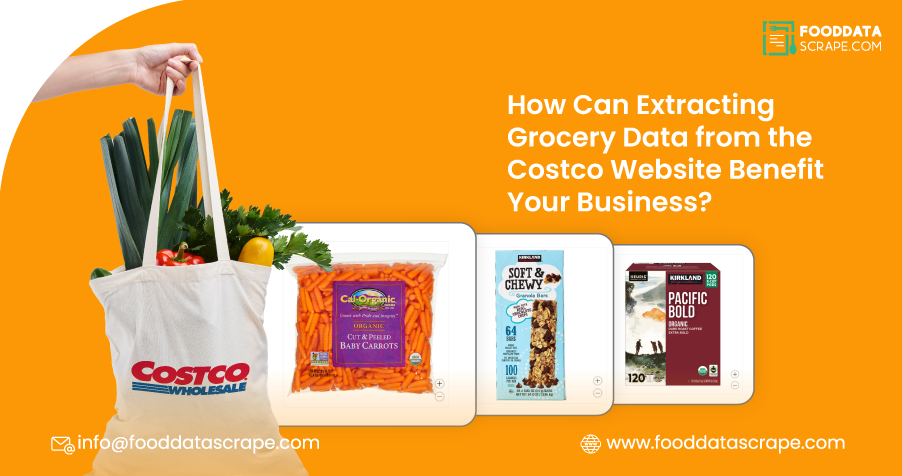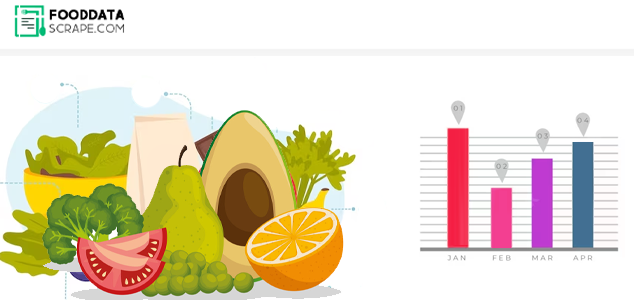Introduction
The digital age has reshaped how businesses and consumers access and analyze grocery data. Internet websites like CostcoCostco's are a veritable gold mine of valuable product information, price, availability, category, and marketplace trends. Extracting grocery data from the Costco website gives businesses, researchers, and consumers sufficient actionable intelligence. Costco's website is necessary for price checks, promotions analysis, or monitoring stock. Web scraping and APIs enable users to obtain data in structured form, which can be easily analyzed and decisions made accurately. Costco grocery price data extraction enables users to monitor price trends, analyze season fluctuations, and monitor competition. Additionally, scraping Costco grocery data for market analysis can identify consumer preferences, regional variations, and overall market trends valuable to retailers, economists, and analysts. Costco data's power can drive competitive programs, price initiatives, and customer information.
Why Extract Grocery Data from Costco?
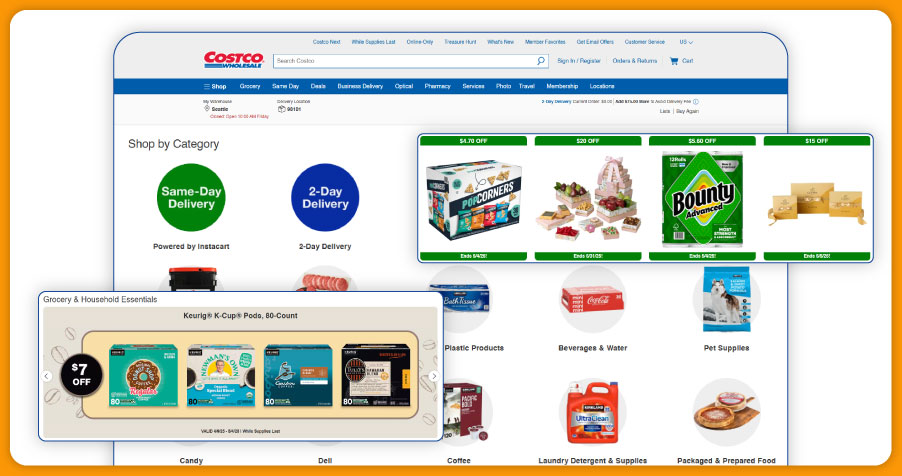
Costco, a leading global wholesale retailer, operates a highly efficient online platform showcasing an extensive range of grocery products, from everyday pantry staples to specialty items. The website offers comprehensive product listings, detailed pricing information, and availability status, making it an excellent source for data extraction. Extract Costco supermarket data to get valuable key areas:
- Market Research: Businesses can leverage Costco's grocery product catalog to conduct market research, analyze emerging trends, monitor pricing strategies, and assess consumer preferences. Insights gathered from web scraping Costco grocery item listings allow companies to make informed decisions based on competitive analysis and market demand.
- Price Comparison: Both consumers and competitors can utilize Costco's pricing data to compare against other retailers. By identifying price variations, businesses can pinpoint cost savings opportunities or adjust their pricing strategies to stay competitive in the market.
- Inventory Tracking: Analysts and retail professionals can use real-time Costco grocery inventory scraping to monitor product stock levels, identify out-of-stock items, and evaluate supply chain dynamics. This data is invaluable for managing inventory and optimizing stocking strategies.
- Consumer Insights: Data on product categories and descriptions can provide valuable insights into consumer behavior and demand shifts. For example, an increase in the number of organic or plant-based items in Costco's catalog could signal growing consumer interest in health-conscious products. This information can help businesses tailor their offerings to match evolving customer preferences.
The well-structured format of Costco's website, combined with its vast selection of grocery items, makes it an ideal platform for Costco grocery data scraping to obtain high-quality, actionable insights across various business sectors.
Types of Grocery Data Available on Costco's Website
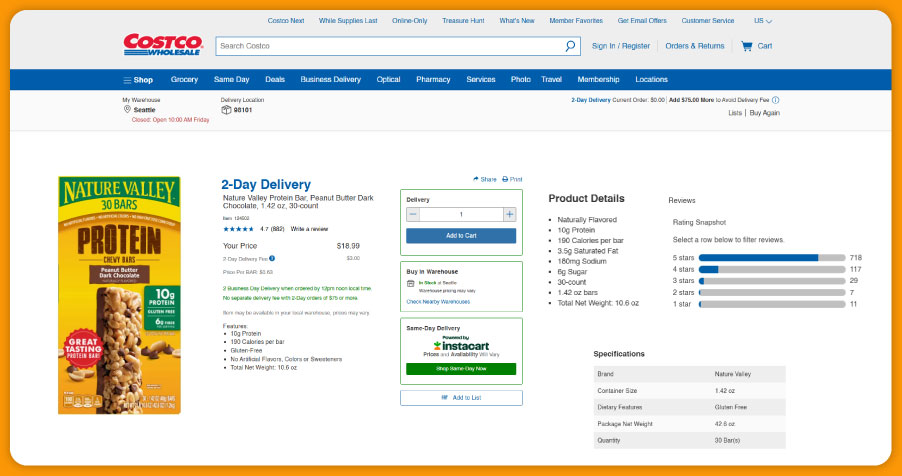
Costco's website organizes grocery products into intuitive categories containing valuable data points. Understanding the types of data available is essential for effective extraction. Key data categories include:
- Product Information: Each grocery item on Costco's website includes a title, description, and unique product ID. For example, a listing for "Kirkland Signature Organic Olive Oil" might include details about its size (e.g., 2 liters), certifications (e.g., USDA Organic), and packaging (e.g., plastic bottle). This information helps identify product specifics and differentiate between similar items.
- Pricing Details: Pricing data is a critical component of Costco's grocery listings. The website displays the regular price, any discounts, and member-exclusive pricing. For instance, a 12-pack of canned soup might list a regular price of $12.99, with a $2 discount for members. Some products also include unit pricing (e.g., $0.50 per ounce), applicable for cost comparisons.
- Availability and Stock Status: Costco's website indicates whether a product is in stock, out of stock, or available only in specific regions. For example, a seasonal item like pumpkin pie mix might be marked as "Available Online Only" or "In-Warehouse Only." This data is vital for tracking inventory trends and regional availability.
- Product Categories and Filters: Costco organizes groceries into categories such as "Beverages," "Snacks & Sweets," "Pantry," and "Frozen Foods." Subcategories and filters (e.g., "Gluten-Free," "Organic," or "Kosher") allow users to refine searches. Extracting category data helps map the retailer's product hierarchy and identify niche markets.
- Customer Reviews and Ratings: Many grocery products feature customer reviews and star ratings. For instance, a cereal box might have a 4.5-star rating based on 200 reviews, with comments about taste or value. This data provides insights into consumer satisfaction and product popularity.
- Images and Packaging Details: Most product listings include high-resolution images that showcase packaging and branding. Extracting image URLs or analyzing visual elements can aid brand recognition and marketing studies.
Tools and Technologies for Data Extraction
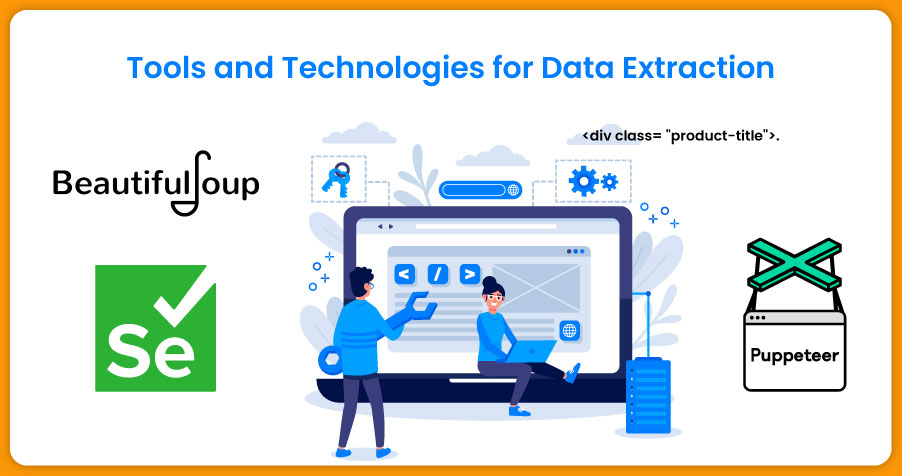
Extracting grocery data from Costco's website requires specialized tools and technologies to navigate its structure and retrieve information efficiently. Below are the primary methods used for data extraction:
- Web Scraping Frameworks: Web scraping frameworks like BeautifulSoup (Python) and Scrapy are popular for extracting data from Costco's website. These tools parse HTML and CSS to locate product details, prices, and categories. For example, BeautifulSoup can extract all product titles from a category page by targeting specific HTML tags, such as <h2> or <div class="product-title">.
- Headless Browsers: Costco's website may use dynamic content loaded via JavaScript, requiring tools like Puppeteer or Selenium. These headless browsers simulate user interactions, such as clicking "Load More" buttons or navigating pagination to access all product categories. Puppeteer, for instance, can scrape data from multiple pages by automating browser actions.
- APIs and Data Extraction Platforms: While Costco does not publicly offer an API for grocery data, third-party data extraction platforms can simplify the process. These tools provide pre-built scraping templates and handle complexities like IP rotation to avoid detection, making them handy for large-scale data extraction.
- Data Storage and Processing: Once extracted, grocery data must be stored and processed for analysis. Tools like pandas (Python) or SQL databases organize data into structured formats, such as CSV or JSON. For example, a pandas DataFrame can store product names, prices, and categories in columns for easy querying.
- Cloud-Based Solutions: Cloud platforms like AWS or Google Cloud facilitate scalable data extraction and storage. AWS Lambda can run scraping scripts on a schedule, while Google BigQuery can store and analyze large datasets. These solutions are ideal for ongoing data collection from Costco's website.
Applications of Extracted Grocery Data
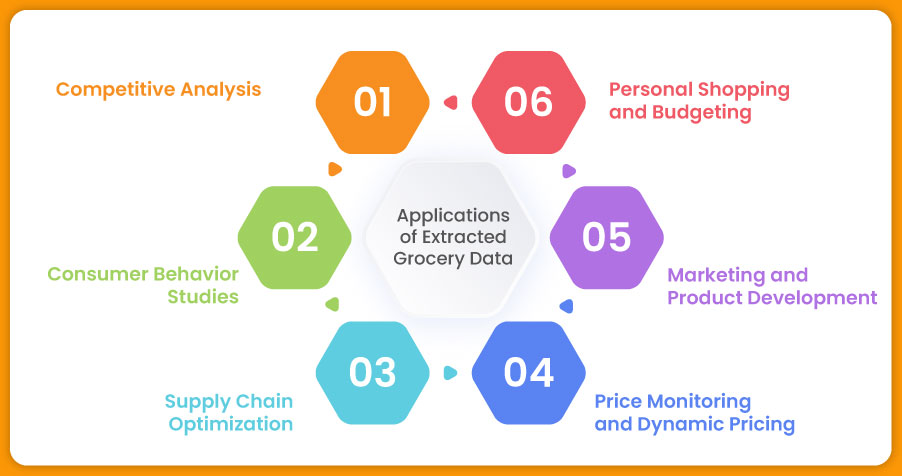
The grocery data extracted from Costco's website has diverse and valuable applications across various industries. Here are some key use cases:
- Competitive Analysis: Retailers and e-commerce platforms can benchmark their pricing and offerings using Costco's grocery data. For example, analyzing Costco's organic food prices can help competitors adjust their pricing strategy or identify gaps in their product inventory. Businesses can also scrape online Costco grocery delivery app data to track Costco's delivery prices and offerings, gaining an edge in the market by comparing and adjusting their prices.
- Consumer Behavior Studies: Researchers can analyze product categories, descriptions, and customer reviews to study emerging consumer trends. For example, the rise in "Vegan" or "Keto" products may highlight changing dietary preferences. Sentiment analysis on reviews can further reveal what drives consumer satisfaction and dissatisfaction. This data can be crucial for brands to adjust their offerings based on real-time feedback. Using Costco grocery delivery scraping API services makes accessing this data at scale easier.
- Supply Chain Optimization: To understand Costco's inventory management strategies, businesses can monitor stock levels and availability. By tracking frequent out-of-stock items or price changes, businesses can identify supply chain issues and work to streamline their processes. Web scraping quick commerce data from Costco enables companies to understand how timely product restocking impacts the pricing and availability of popular items.
- Price Monitoring and Dynamic Pricing: E-commerce platforms can use Costco's pricing data to implement dynamic pricing models. By continuously monitoring Costco's prices and promotional offers, platforms can adjust their prices accordingly to stay competitive. For example, leveraging grocery price dashboard tools can help businesses keep track of price fluctuations and offer competitive deals or create bundles that mirror Costco's value propositions.
- Marketing and Product Development: Brands can analyze product categories and customer reviews to inform their marketing strategies or develop new products. For instance, if there is a growing demand for gluten-free snacks at Costco, brands can consider launching similar products to meet that need. Grocery app data scraping services can also help gather data on which products have the highest demand, allowing businesses to target their marketing efforts more effectively.
- Personal Shopping and Budgeting: Extracted data allows for more efficient budgeting and shopping for consumers. Personalized shopping lists can be created by comparing Costco's prices with other retailers, ensuring consumers find the best deals. Data-driven tools based on Costco's pricing, availability, and product categories can recommend the best shopping options based on a user's specific budget or dietary requirements. With grocery delivery scraping API services, consumers can easily track fluctuating prices and ensure they always get the best deals on their grocery purchases.
By utilizing these tools and strategies, businesses and consumers can leverage Costco's extensive grocery data to gain a competitive edge, optimize operations, and make informed decisions based on real-time information.
Best Practices for Effective Data Extraction
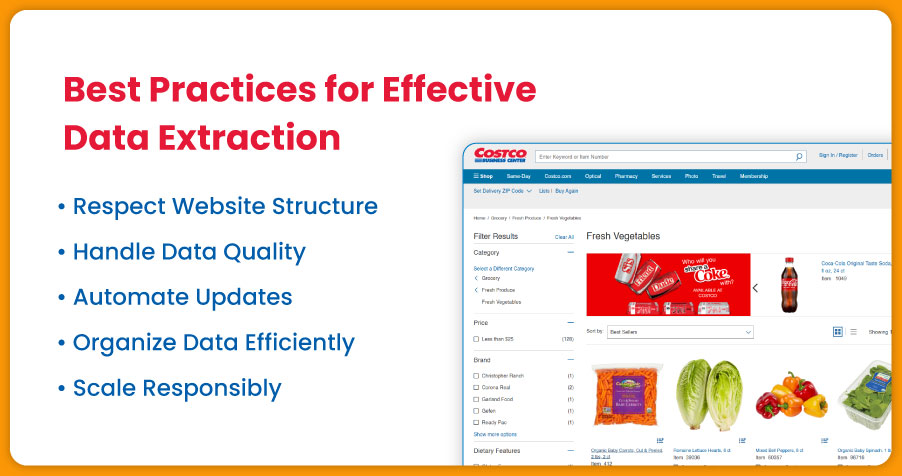
To maximize the value of grocery data extracted from Costco's website, consider the following best practices:
- Respect Website Structure: Understand Costco's website layout, including pagination, filters, and dynamic content, to design efficient scraping scripts.
- Handle Data Quality: Clean extracted data to remove duplicates, correct formatting issues, or fill in missing values. For example, standardize price formats (e.g., "$12.99" instead of "12.99 USD").
- Automate Updates: Schedule scraping tasks to capture real-time changes in pricing or availability, ensuring data remains current.
- Organize Data Efficiently: Use clear naming conventions and structured formats (e.g., CSV, JSON) to simplify analysis and sharing.
- Scale Responsibly: Use cloud-based tools or proxies to manage load and avoid overwhelming Costco's servers for large-scale extraction.
Unlock actionable grocery data today—contact us to start scraping and gaining a competitive edge!
Future Trends in Grocery Data Extraction
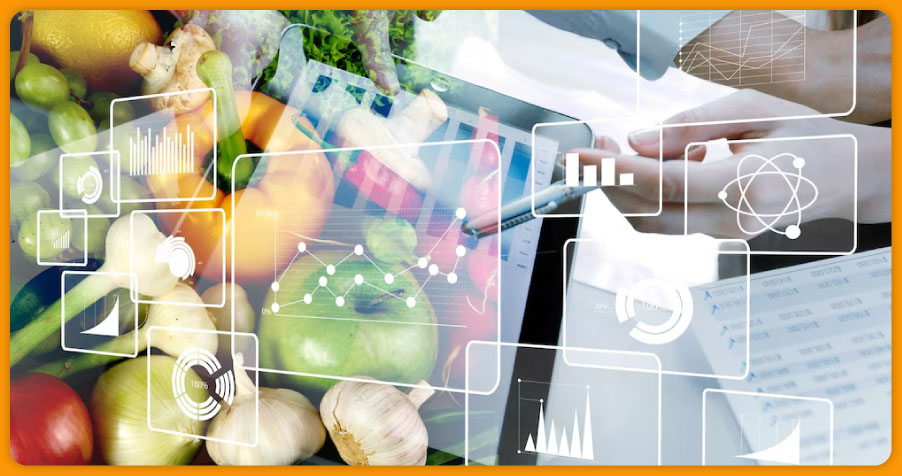
As e-commerce continues to evolve, the extraction of grocery data from platforms like Costco's website will become increasingly sophisticated. Emerging trends include:
- AI-Powered Scraping: Machine learning models can improve data extraction by identifying patterns in website structures or predicting product updates.
- Real-Time Data Pipelines: Advanced tools will enable continuous data extraction and analysis, providing instant insights into pricing or inventory changes.
- Integration with IoT: Smart home devices, like connected refrigerators, could use extracted grocery data to suggest restocking based on Costco's inventory.
- Personalized Data Solutions: Platforms may offer tailored data extraction services, allowing users to specify exact product categories or data points.
How Food Data Scrape Can Help You?
- Customizable Data Extraction: We offer tailored solutions to scrape grocery data from various platforms, ensuring you get the exact information you need—pricing, availability, or product details.
- Real-Time Data Collection: Our services enable real-time grocery data scraping, keeping you updated on market trends, inventory levels, and pricing fluctuations for accurate decision-making.
- Comprehensive Data Insights: With our expertise in grocery price tracking, we provide comprehensive datasets, helping businesses analyze market trends, identify cost-saving opportunities, and optimize their strategies.
- Scalable Solutions: Our tools are designed to handle large-scale data scraping, allowing you to gather grocery data across multiple platforms without compromising speed or accuracy.
- API Integration: We provide robust grocery data scraping API services, ensuring seamless integration with your systems for easy data extraction and continuous monitoring.
Conclusion
Extracting grocery data from Costco's website offers businesses, researchers, and consumers numerous opportunities to gain valuable insights. By analyzing product information, pricing, availability, and customer reviews, stakeholders can better understand market trends, refine their business strategies, and improve decision-making. Accessing detailed grocery store datasets allows for efficient price comparisons, inventory management, and consumer behavior analysis. Additionally, using grocery pricing data intelligence helps businesses stay ahead of the competition by monitoring pricing trends. Moreover, a grocery price tracking dashboard can empower consumers and companies to make data-driven purchasing decisions, ensuring they capture the best deals and optimize their buying strategies. As technology continues to evolve, the possibilities for innovative uses of Costco's grocery data will expand.
Are you in need of high-class scraping services? Food Data Scrape should be your first point of call. We are undoubtedly the best in Food Data Aggregator and Mobile Grocery App Scraping service and we render impeccable data insights and analytics for strategic decision-making. With a legacy of excellence as our backbone, we help companies become data-driven, fueling their development. Please take advantage of our tailored solutions that will add value to your business. Contact us today to unlock the value of your data.






















































































